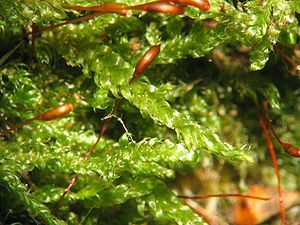Hypnum
| Hypnum | ||||||||||||
|---|---|---|---|---|---|---|---|---|---|---|---|---|

|
||||||||||||
| Systematics | ||||||||||||
|
||||||||||||
| Scientific name | ||||||||||||
| Hypnum | ||||||||||||
| Hedw. |
The sleeping mosses ( Hypnum ) describe a pleurocarpic deciduous moss genus. In the Middle Ages , the different types of dried were used for pillow and mattress fillings. In some regions of Germany the mosses were also used directly as sleeping camps. Subfossil finds from northern Germany prove this use. However, it should also be mentioned that in the Middle Ages all larger astmosses were assigned to sleeping mosses. It is not surprising that its German name comes from this time. Hypnum comes from the Greek hypnos , which means sleep.

features
The sleeping mosses are green to yellow-brown colored, glossy, pleurocarpic mosses that develop soft to strong lawns. Their trunks can grow prostrate as well as ascending and are usually irregular or, less often, regularly pinnately branched. In some species the stems show a hyalodermis , i. H. a bark of large, water-white cells.
The lanceolate-shaped, short or long pointed leaves are usually one-sided, with short, hook-shaped leaf tips as well as sickle-shaped or circular leaves. In the outer area at the leaf base they often show a clearly differentiated leaf wing cell network, the cells of which are shorter, rectangular, often brownish, and in many species they are inflated. Under the microscope, prosenchymatic lamina cells can be seen within the leaf . The leaf vein is either short and double or absent entirely.
The always inclined capsules of the Sporogons stand on a long seta . They also have a double peristome .
Systematics / types (selection)
The sleeping mosses are a cosmopolitan (apart from Antarctica ) common genus. However, they are particularly rich in species in temperate areas of the world.
The genus was previously used as a collective group for a wide variety of pleurocarp moss with a prosenchymatic leaf cell network without rib, which could not be assigned differently, which is why parts have been separated into other genera again and again.
Most species characteristics show a high degree of variability and deviate greatly, especially in the case of plants in very wet or dry locations. For this reason, on the one hand, some of the species have not yet been clearly defined, on the other hand, it is not possible to clearly assign every plant, even if it belongs to one of the well-defined species. However, these problems have been fixed for at least a good part of the genre by the work of Hisatsugu Ando .
Depending on the view, the genus includes around 50 to 200 species worldwide. About 15 of these occur in Europe.
- Hypnum andoi
- Hypnum bambergeri
- Hypnum callichroum
- Cypress sleeping moss ( Hypnum cupressiforme )
- Hypnum fertile
- Hypnum hamulosum
- Hypnum imponens
- Heath sleeping moss ( Hypnum jutlandicum )
- Swollen cypress sleep moss ( Hypnum lacunosum )
- Crooked Sleeping Moss ( Hypnum lindbergii )
- Hypnum pallescens
- Hypnum pratense
- Hypnum recurvatum
- Hypnum resupinatum
- Hypnum revolutum
- Hypnum sauteri
- Trilateral astmoss ( Hypnum triquetrum )
- Hypnum vaucheri
literature
- Dietmar Aichele, Heinz-Werner Schwegler: Our moss and fern plants. An introduction to the way of life, the construction and the recognition of native mosses, ferns, bear moss and horsetail. 10th edition. Franckh-Kosmos, Stuttgart 1993, ISBN 3-440-06700-9 .
- Ruprecht Düll : Excursion pocket book of the mosses. An introduction to moss science with special consideration of the biology and ecology of the most important mosses in Germany and for the magnification of the easily recognizable species in the area. 4th, improved, supplemented edition. IDH - Verlag für Bryologie und Ökologie, Bad Münstereifel 1993, ISBN 3-925425-00-4 .
- Jan-Peter Frahm , Wolfgang Frey : Moosflora (= UTB . 1250). 4th, revised and expanded edition. Ulmer, Stuttgart 2004, ISBN 3-8252-1250-5 .
- Bryophyte Flora of North America - Hypnum .
